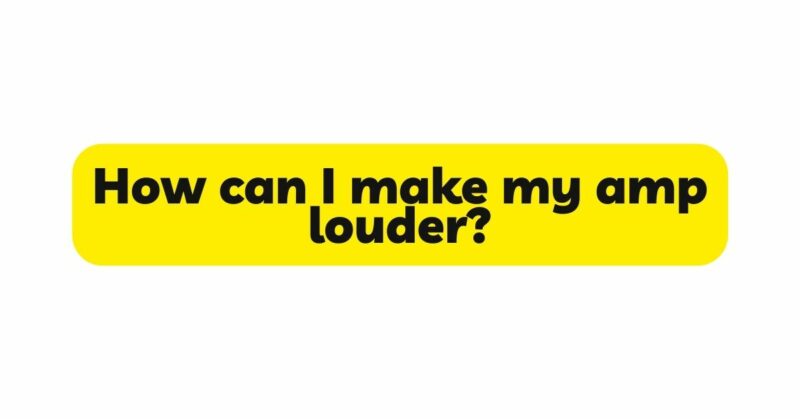Whether you’re a guitarist, a music enthusiast, or a performer, the desire for a louder amp is a common pursuit. Achieving a higher volume output from your amplifier can enhance your musical experience, captivate audiences, and provide a powerful sound presence. In this article, we will explore various techniques and strategies that can help you make your amp louder without compromising on sound quality or risking damage to your equipment.
- Understand Your Amp’s Potential: Before diving into specific methods, it’s crucial to understand the limitations and capabilities of your amplifier. Different types of amplifiers, such as solid-state, tube, or digital, have varying characteristics and power capacities. Refer to your amp’s manual or specifications to familiarize yourself with its power rating, wattage, and any additional features that can affect its volume output.
- Optimize Gain Staging: Proper gain staging is fundamental to maximizing the volume of your amp. Gain staging refers to the process of setting appropriate levels at each stage of your signal chain, from your instrument to the amplifier. Start by ensuring that your guitar or other sound source is outputting a strong signal. Adjust the volume and gain controls on your instrument to provide a robust input signal to the amp, allowing it to amplify effectively.
- Adjust the Volume and Gain Controls: Most amplifiers have volume and gain controls that directly impact the loudness and tone. Experimenting with these controls can help you find the sweet spot for achieving a louder sound. Increase the volume control on your amp to higher levels while monitoring the overall sound quality and potential distortion. Simultaneously, adjust the gain control to find the right balance that provides a boosted signal without introducing unwanted noise or clipping.
- Explore Tone Controls and EQ: Utilizing the tone controls and equalizer (EQ) settings on your amp can significantly impact the perceived volume and overall tonal balance. Adjusting the bass, midrange, and treble controls can shape your sound and make it more prominent in the mix. Experiment with these settings to find the ideal EQ balance that enhances your desired volume output while maintaining clarity and tonal integrity.
- Consider an Overdrive or Distortion Pedal: Adding an overdrive or distortion pedal to your setup can provide a significant volume boost and add an extra layer of richness to your tone. These pedals can push the amp’s preamp section harder, resulting in a more saturated and aggressive sound. Additionally, they often have volume controls that allow you to further increase the overall output level while adding character to your sound.
- Upgrade Your Speakers: The quality and capability of your speakers have a direct impact on the overall volume output of your amp. Investing in higher-quality speakers with higher wattage ratings and efficiency can significantly increase the volume potential. Look for speakers that can handle the power output of your amplifier and have a sensitivity rating that allows for efficient sound reproduction at higher volumes.
- Consider Adding an Extension Cabinet: An extension cabinet is an additional speaker cabinet that can be connected to your amp to expand its sound projection and increase volume. This is particularly useful for guitarists using combo amps, as the built-in speaker might have limitations in terms of size and power handling. By adding an extension cabinet, you can spread the sound across a larger area and achieve a more significant volume boost.
- Utilize Power Soak or Attenuator: Power soaks or attenuators are devices that allow you to reduce the output power of your amplifier while maintaining its tone and characteristics. They sit between the amp and the speaker and enable you to drive your amp harder at lower volume levels. This can be beneficial when playing in environments where high volume levels are restricted, allowing you to achieve the desired amp saturation and tonal richness without excessive volume.
- Explore Amp Modeling and Digital Solutions: If you’re using a digital or modeling amp, there are often additional features and settings that can help you increase volume without sacrificing sound quality. Explore the amp’s built-in effects, presets, and output settings to find options for boosting volume or optimizing the sound for a louder output. Digital amplifiers often have the advantage of flexibility and versatility, allowing you to tailor the volume and tone to your specific requirements.
- Ensure Proper Cabinet Placement: The placement of your amp and speaker cabinet can significantly impact the perceived volume and sound projection. Placing your amp on an elevated surface or angling it upwards can help direct the sound more effectively and project it to a wider area. Consider experimenting with different placements to find the optimal position that maximizes volume and sonic impact.
Conclusion: Increasing the volume of your amplifier requires a combination of proper setup, gain staging, and equipment optimization. Understanding your amp’s capabilities, adjusting volume and gain controls, and exploring tone shaping options are crucial steps. Additionally, upgrading speakers, adding extension cabinets, utilizing power soaks or attenuators, and considering digital solutions can provide significant volume boosts. Remember to maintain a balance between volume and sound quality, and always be mindful of your equipment’s limitations. By implementing these strategies, you can unlock the full potential of your amp and enjoy a louder, more impactful musical experience.


